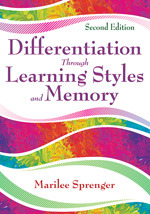Differentiation Through Learning Styles and Memory
- Marilee Sprenger - Aurora University, IL
Brain-Friendly Teaching & Learning | Learning Styles | Student Engagement & Motivation
"This is the kind of book that needs to be read and reread. There's so much usable information. A great resource for all teachers."
—William Fitzhugh, Fifth-Grade Teacher
Reisterstown Elementary School, MD
"The stories and classroom situations throughout the book really helped me visualize how all of this can be put to use. The author definitely practices what she preaches, whether she is teaching in a classroom or teaching through the written word."
—Kathy Tritz-Rhodes, Principal
Marcus-Meriden-Cleghorn Elementary School, IA
Help students lead with their strengths and gain a deeper understanding of concepts!
Students' learning styles are as diverse as the students themselves, so how can teachers reach all learners according to their strengths?
In this updated edition of the bestseller, Marilee Sprenger demonstrates how to optimize learning by using brain-based strategies that address students' social/emotional, cognitive, and physical learning preferences. The author provides readers with graphic organizers, current research on memory, and new charts to help implement differentiated strategies, and also offers:
- An explanation of how the brain processes, stores, and retains information
- Pre-assessment strategies for each learning style
- "Reflect and Connect" questions to help teachers evaluate their current classroom practice
- Learning and memory tips for students
- Exit cards, or quick assessments of what students have learned
This comprehensive resource provides the tools you need to create a brain-friendly learning environment and to differentiate content, process, and product for your students' diverse learning needs and strengths.
"This is the kind of book that needs to be read and re-read. There’s so much usable information in it. A great resource for all teachers."
"Provides many useful and helpful techniques that can immediately be implemented to improve learning in any classroom setting."
“The stories and classroom situations throughout the book really helped me visualize how all of this can be put to use. The author definitely practices what she preaches, whether she is teaching in a classroom or teaching through the written word.”
